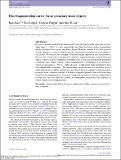Disc fragmentation rarely forms planetary-mass objects
Abstract
It is now reasonably clear that disc fragmentation can only operate in the outer parts of protostellar discs (r > 50 au). It is also expected that any object that forms via disc fragmentation will have an initial mass greater than that of Jupiter. However, whether or not such a process actually operates, or can play a significant role in the formation of planetary-mass objects, is still unclear. We do have a few examples of directly imaged objects that may have formed in this way, but we have yet to constrain how often disc fragmentation may actually form such objects. What we want to consider here is whether or not we can constrain the likely population of planetary-mass objects formed via disc fragmentation by considering how a population of objects at large radii (a > 50) au - if they do exist - would evolve under perturbations from more distant stellar companions. We find that there is a specific region of parameter space to which such objects would bes cattered and show that the known exoplanets in that region have properties more consistent with that of the bulk exoplanet population, than with having been formed via disc fragmentation at large radii. Along with the scarcity of directly imaged objects at large radii, our results provide a similar, but independent, constraint on the frequency of objects formed via disc fragmentation.
Citation
Rice , K , Lopez , E , Forgan , D & Biller , B 2015 , ' Disc fragmentation rarely forms planetary-mass objects ' , Monthly Notices of the Royal Astronomical Society , vol. 454 , no. 2 , pp. 1940-1947 . https://doi.org/10.1093/mnras/stv1997
Publication
Monthly Notices of the Royal Astronomical Society
Status
Peer reviewed
ISSN
0035-8711Type
Journal article
Description
KR gratefully acknowledges support from STFC grant ST/M001229/1. The research leading to these results also received funding from the European Union Seventh Framework Programme (FP7/2007-2013) under grant agreement number 313014 (ETAEARTH). DF grateful acknowledges support from the ECOGAL ERC advanced grant.Collections
Items in the St Andrews Research Repository are protected by copyright, with all rights reserved, unless otherwise indicated.

